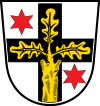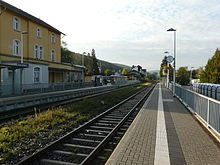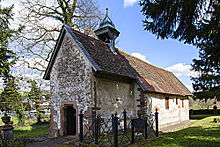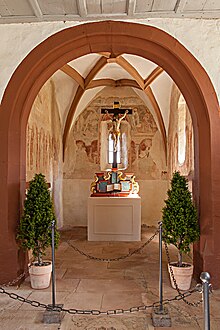Bad King
| coat of arms | Germany map | |
|---|---|---|

|
Coordinates: 49 ° 44 ' N , 9 ° 0' E |
|
| Basic data | ||
| State : | Hesse | |
| Administrative region : | Darmstadt | |
| County : | Odenwaldkreis | |
| Height : | 182 m above sea level NHN | |
| Area : | 46.73 km 2 | |
| Residents: | 9759 (Dec. 31, 2019) | |
| Population density : | 209 inhabitants per km 2 | |
| Postal code : | 64732 | |
| Area code : | 06063 | |
| License plate : | ERB | |
| Community key : | 06 4 37 001 | |
| LOCODE : | DE ADK | |
| City structure: | 7 districts | |
City administration address : |
Schloßplatz 3 64732 Bad König |
|
| Website : | ||
| Mayor : | Axel Muhn (Independent) | |
| Location of the city of Bad König in the Odenwald district | ||
Bad König is a spa town in the Odenwaldkreis in southern Hesse . The city is a recognized spa .
geography
Neighboring communities
Bad König borders in the north on the municipalities of Höchst and Lützelbach , in the east and south on the city of Michelstadt and in the west on the municipalities of Brombachtal and Brensbach .
City structure
In addition to the core town of Bad König, the town includes the districts of Zell , Momart , Etzen-Gesäß , Fürstengrund , Kimbach , Nieder-Kinzig and Ober-Kinzig (with Mittel-Kinzig and Gumpersberg ).
history
"Quinticha" is the name with which Bad König is mentioned in a document from 820 to 822 . In the Middle Ages it was originally owned by the empire and then belonged to the imperial monastery of Fulda . Bad König was fortified in the early Middle Ages and was the focus of a central court and central office. In 1477 "Künnig as Chur Maintzisch Lehn" was given to the Konrad von Erbach tavern. By no later than the 16th century who built Counts of Erbach , the bathroom lock king in today's town center. According to the division of Erbach in 1747, the office of König came into the possession of the counts of the Erbach- Schönberg line . As part of the county of Erbach, the place belonged to the Franconian Empire .
In 1900, the engagement of Queen Wilhelmina of the Netherlands to Duke Heinrich zu Mecklenburg took place in Bad König . There were family ties to the Grafenhaus: Wilhelmina's mother Emma zu Waldeck and Pyrmont was a sister of Countess Elisabeth zu Erbach-Schönberg.
The beginnings as a spa go back to the 19th century and the discovery of two healing springs. In February 1948, the municipality of König was granted the right to use the place name "Bad-König" by the Hessian Minister of the Interior. It was only in 1948 that Bad-König was allowed to call itself a "state-approved bathroom". The official spelling was changed in June 1952 from "Bad-König" to "Bad König". On October 10, 1980, the Odenwald spa was granted city rights. The spa center is in the process of modernization thanks to new buildings after 2000 (Odenwald thermal baths and new foyer).
Incorporations
On October 1, 1971, the independent communities of Fürstengrund , Kimbach , Momart , Nieder-Kinzig and Ober-Kinzig were incorporated. Etzen-Gesäß and Zell were added on August 1, 1972.
Jewish community
There was a Jewish community in (Bad) König until 1939. Its origins go back to the 18th century. The highest number of Jewish residents was reached around 1880 with 100 people. The community was orthodox . The Jewish families owned cattle and horse traders, grain and flour traders as well as shops for manufactured goods, colonial goods, glass and porcelain. The J. Mannheimer company had a large agricultural machinery business. There was a kosher pension for Jewish spa guests . The future rabbi David Mannheimer (1863–1919) comes from König . He officiated in Oldenburg (Oldb) , in the Grand Duchy of Oldenburg, as a land rabbi from 1891 until his death in 1919. He is buried in the Jewish cemetery in Oldenburg . The synagogue , built in 1795/97, was badly damaged in the November pogrom in 1938 and demolished in 1939. In 1933, 72 Jewish people were still living in the city. Due to extremely brutal scenes in connection with the November pogrom, most of them left the place, especially since they had not been allowed to buy food since 1939. At least ten Jewish people from Bad König were murdered after the deportations .
politics
City Council
The local elections on March 6, 2016 produced the following results, compared to previous local elections:
| Parties and constituencies |
% 2016 |
Seats 2016 |
% 2011 |
Seats 2011 |
% 2006 |
Seats 2006 |
% 2001 |
Seats 2001 |
||
|---|---|---|---|---|---|---|---|---|---|---|
| SPD | Social Democratic Party of Germany | 36.4 | 10 | 32.3 | 9 | 44.2 | 12 | 42.3 | 13 | |
| CDU | Christian Democratic Union of Germany | 24.3 | 6th | 26.6 | 7th | 45.2 | 12 | 45.7 | 14th | |
| ZBK | Future Bad König | 32.0 | 9 | 26.6 | 7th | - | - | - | - | |
| GREEN | Alliance 90 / The Greens | 7.4 | 2 | 8.7 | 2 | 4.4 | 1 | - | - | |
| BL | Bad König Citizens List | - | - | 5.8 | 2 | - | - | - | - | |
| FDP | Free Democratic Party | - | - | - | - | 6.2 | 2 | 2.9 | 1 | |
| GAL | Green alternative list Bad König | - | - | - | - | - | - | 6.7 | 2 | |
| ÜWG | Non-partisan voter community Bad König | - | - | - | - | - | - | 2.4 | 1 | |
| total | 100.0 | 27 | 100.0 | 27 | 100.0 | 27 | 100.0 | 31 | ||
| Voter turnout in% | 47.9 | 47.9 | 47.4 | 59.6 | ||||||
Local advisory boards exist in the districts of Etzen-Gesäß, Momart, Nieder-Kinzig, Ober-Kinzig and Zell. Fürstengrund and Kimbach have had no local councils since the 2016 local elections.
mayor
As of 2006, the mayor of the city of Bad König was Uwe Veith . On October 9, 2012, he defended his position with 72.8% of the vote. In the election on October 28, 2018, he was defeated by the independent applicant Axel Muhn, who won the election with 60.1% of the vote.
badges and flags
coat of arms
|
Blazon : “A continuous black cross in silver, which is covered with a golden trunk and three golden oak leaves growing from it; a six-pointed red star each in the upper right and lower left corner. "
The coat of arms of the municipality of König was approved by the Hessian Ministry of the Interior on May 25, 1927. Since the first documentary mention around 800, the settlement belonged to the Fulda tax authority Umstadt. In the 14th century the taverns of Erbach gained a foothold here and soon became sole owners of the heavily fortified place, which was also the center of a cent court . The cross and the Erbach stars refer to the affiliation to the Imperial Abbey of Fulda and later to the Counts of Erbach. The stylized oak refers to the cent court and the ancient centimeter mark that was used by König. |
|
flag
On August 15, 1952, the municipality of Bad König in what was then the district of Erbach was approved by the Hessian Ministry of the Interior to carry a flag in the colors red-white-red with a coat of arms.
Town twinning
Bad König has been twinned with Argentat in the Nouvelle-Aquitaine region in southwest France since 1982 .
Economy and Infrastructure
Jakob Maul GmbH, located in Zell since 1912, is a commercial enterprise .
Spa facilities and medical facilities
Two springs were discovered at the end of the 19th century: a steel spring containing iron and manganese and a 32 ° C thermal spring (Odenwald spring), a sodium-calcium-magnesium-bicarbonate-sulfate-chloride-water. Both were initially used for drinking cures.
Bad König has been a state-approved spa since 1948. Today it is changing from a conventional health resort to a contemporary wellness and leisure center. It is also a rehabilitation therapy center and has several clinics
- Asklepios Schlossberg Clinic (early rehabilitation for brain damage)
- Odenwaldklinik (specialist clinic with a focus on oncology and diseases of the musculoskeletal system, currently out of service)
- ZFM Center for Far Eastern Medicine and Naturopathic Treatment GmbH + Co KG
and a dense network of doctors and pharmacies.
In 1952 there were the first initiatives to redesign the marshy meadow ground of the Mümling into a spa park. With considerable technical effort, two artificial lakes (since 1991 with water fountains), surrounded by green areas and promenade paths, were created in the 1960s. The spa park is now an extended family amusement park with a restaurant and beer garden, mini golf course, open-air chess, bocce court, Kneipp water treading pool (1987) and tennis courts and, since spring 2012, a water playground. There are organized Nordic walking and spa park running activities. In July 2012, 10 large sandstone sculptures by various sculptors were placed in the park. One of the Nordic Walking routes partly coincides with a planetary path of approx. 3 km length, laid out in 1997 , on which the sun and the nine planets of our solar system are explained at ten stations; the stations are at a distance from one another that corresponds to the constellation in the solar system. The explanation boards for the sun and the inner planets are located one behind the other in the entrance area of the spa park, the last station (Pluto) on the border with the Zell district. The astronomical didactic program in the spa park has included three sundials since 1987 , on which the true local time (WOZ), which was valid until 1893 , the CET and summer time are explained; the natural midday (highest point of the sun) in Bad König (9 ° east longitude) is 24 minutes later than midday on the 15th degree of longitude (Görlitz time), which is decisive for setting CET at 12:00; in summer - one hour later - the highest level of the sun in Bad König is at 1:24 p.m. (Görlitz 1:00 p.m.).
In the past, spa treatments for muscle and joint problems, metabolic and vegetative disorders included carbonic acid and oxygen baths, underwater massages, mud packs and bathtubs; the counterpart in leisure time was determined by traditional local lectures, theater performances, spa concerts and tea dances in the spa café of the former foyer. This foyer of the spa center was replaced by a new building in 2010/2011, in which events take place regularly. The fountain hall, in which the Bad Königer medicinal water can be tasted, is located in the same building.
In 2000 the Odenwald-Therme with the 32 ° C warm thermal water (indoor and outdoor pools, bubble loungers, flow channel, whirlpool) and sauna area was opened. Today's spa treatments in the thermal bath include aqua fit gymnastics and massages, thalasso therapies, peelings, physio-therm infrared treatments and 45-minute inhalation stays in a salt cave with a mixture of Himalayan and Black Sea salt for the treatment of allergies and Clear the upper respiratory tract.
traffic
The city is connected to the transport network through the federal highway 45 ( Hanau - Eberbach ). The Odenwaldbahn (RMV lines 80, 81, 82, 85) connects Bad König and the Zell district with the Neckar Valley as well as Frankfurt and Darmstadt .
Bike trails
The following cycle paths lead through the city :
- On the Mümling, the 225 km long 3-country cycle path runs as a circular route through the triangle of Hesse, Baden-Württemberg and Bavaria. The route explores the Odenwald along the Mümling, Neckar and Main rivers. Part of this route is the 75-kilometer Mümling cycle path that connects Obernburg with Hirschhorn am Neckar .
- The Hessian long-distance cycle route R4 begins in Hirschhorn am Neckar and runs with a total length of 385 kilometers from south to north through Hesse, along from Mümling, Nidda and Schwalm to Bad Karlshafen an der Weser.
Attractions
The sights are concentrated around the palace square with the Bad König palace , consisting of the old and new palace, rent office , Protestant church, baroque open staircase and pleasure garden. There is also a local museum for documentation of local handicrafts.
The baroque Protestant church (1750–1751) still has a three- story fortified church tower from 1479 from the previous building, which was integrated into the fortified cemetery (foundation stone with inscription in the basement). A Roman tombstone with the inscription "DML SEXTII VALE" was integrated into the masonry on the second floor; it is now in the gate of the renting department and was replaced by a copy on the spot. Above the sandstone portal on the west side (inscription dated 1751) is the coat of arms of the house of Erbach flanked by two putti. The interior is a hall with a flat ceiling and an organ from the 18th century.
The Villa Lien used as a health clinic is an important representative building of historicism.
Since 1999 a small museum with paintings and drawings as well as stuffed animals has been dedicated to the local painter Georg Vetter .
Approx. 1 km east of the city in the Kimbacher Tal is the Romanesque cemetery chapel with a late Gothic vestibule from 1514, a rectangular nave and a rectangular recessed choir (14th century). It is the oldest building in Bad König. Its structural core goes back at least to the 11th century, but it can also be older. However, the thesis that the predecessor was of Carolingian origin has not yet been confirmed. It only became a cemetery chapel when the congregation's burial place was relocated to the chapel during the reconstruction of the parish church in Bad König in connection with the structural redesign of the castle area. The year 1771 above the cemetery chapel heralds this last change of destination. During restoration work in spring 2005, wall paintings from the 14th century (figures of saints and passion scenes) were uncovered.
Personalities
- Christian zu Erbach-Schönberg (1728–1799), governor of the Teutonic Order and ruling count in König
- Franz Taurinus (1794–1874), mathematician
- Friedrich Bergsträsser (1800–1847), Hessian politician and former liberal-conservative member of the 2nd Chamber of the Estates of the Grand Duchy of Hesse
- Lorenz Büchner (1817–1860), mayor of (Bad) König and father of Gottfried Büchner
- Johann Adam Groh (1824–1881), co-founder of the agricultural cooperative associations in Hesse
- Carl Weyprecht (1838–1881), polar explorer
- Gottfried Büchner (1851-1919), Mayor of (Bad) König and liberal Hessian member of the state parliament
- David Mannheimer (1863-1919), Grand Ducal Oldenburg regional rabbi and field rabbi of the Imperial Navy in Wilhelmshaven
- Georg Vetter (1891–1969), painter
- Otto Malfeld (1921–2013), SPD politician, mayor of Wetzlar
- Walter Treser (* 1940), engineer, project manager and namesake of the Audi quattro
- Peter Sehr (1951–2013), film director
- Herbert Rebscher (* 1954), entrepreneur, CEO of the DAK
- Frank Philipp Schlößmann (* 1963), stage designer
Web links
- Website of the city of Bad König
- Bad König, Odenwaldkreis. Historical local dictionary for Hessen. In: Landesgeschichtliches Informationssystem Hessen (LAGIS).
- Literature about Bad König in the Hessian Bibliography
- Link catalog on the subject of Bad König at curlie.org (formerly DMOZ )
- Literature on Bad König in the catalog of the German National Library
Individual evidence
- ↑ Hessian State Statistical Office: Population status on December 31, 2019 (districts and urban districts as well as municipalities, population figures based on the 2011 census) ( help ).
- ↑ 79th meeting of the specialist committee for health resorts, recreational areas and healing wells in Hesse on November 21, 2012 . In: State pointer for the state of Hesse . No. 9 , 2014, ISSN 0724-7885 , p. 187 .
- ↑ Granting the right to use the place name "Bad-König" on February 5, 1948 . In: The Hessian Minister of the Interior (ed.): State Gazette for the State of Hesse. 1948 no. 7 , p. 53 , point 67 ( online at the information system of the Hessian state parliament [PDF; 2.7 MB ]).
- ↑ Change of the spelling of the municipality Bad-König in the district Erbach, reg.-district Darmstadt from June 10, 1952 . In: The Hessian Minister of the Interior (ed.): State Gazette for the State of Hesse. 1952 No. 26 , p. 487 , point ( online at the information system of the Hessian state parliament [PDF; 2.7 MB ]).
- ↑ a b Federal Statistical Office (ed.): Historical municipality register for the Federal Republic of Germany. Name, border and key number changes in municipalities, counties and administrative districts from May 27, 1970 to December 31, 1982 . W. Kohlhammer, Stuttgart / Mainz 1983, ISBN 3-17-003263-1 , p. 358 f .
- ↑ Odenwaldtherme - thermal bath and sauna area in the Odenwald. In: odenwald-therme.de. Retrieved March 5, 2016 .
- ↑ Law on the reorganization of the district of Erbach (GVBl. II 330–16) of July 11, 1972 . In: The Hessian Minister of the Interior (ed.): Law and Ordinance Gazette for the State of Hesse . 1972 No. 17 , p. 224 , § 3 ( online at the information system of the Hessian state parliament [PDF; 1,2 MB ]).
- ^ The synagogue in Bad König (Odenwaldkreis). In: alemannia-judaica.de. Retrieved March 5, 2016 .
- ^ Result of the municipal election on March 6, 2016. Hessian State Statistical Office, accessed in April 2016 .
- ^ Hessian State Statistical Office: Result of the municipal elections on March 27, 2011.
- ^ Hessian State Statistical Office: Result of the municipal elections on March 26, 2006.
- ↑ Uwe Veith defends his office in Bad König. In: echo-online.de. Echo Newspapers GmbH, archived from the original on March 5, 2016 ; Retrieved March 5, 2016 .
- ↑ Direct elections in Bad König, city. Hessian State Statistical Office , accessed in December 2018 .
- ^ Klemens Stadler : The municipal coat of arms of the state of Hesse . New edition of the collection of German local coats of arms by Prof. Otto Hupp on behalf of HAG Aktiengesellschaft in Bremen, edited by Dr. Klemens Stadler, drawings by Max Reinhart (= German coat of arms - Federal Republic of Germany . Volume 3 ). Angelsachsen-Verlag, Bremen 1967, p. 18 .
- ↑ Authorization to fly a flag to the community of Bad König in the Erbach district, Darmstadt district from August 15, 1952 . In: The Hessian Minister of the Interior (ed.): State Gazette for the State of Hesse. 1952 No. 35 , p. 654 , item 856 ( online at the information system of the Hessian state parliament [PDF; 3,4 MB ]).
- ↑ Manfred Giebenhain: How the restaurateur's problem becomes a blessing. In: echo-online.de. February 26, 2016, accessed on June 28, 2016 (newspaper article on the discovery of the healing water of Bad König).
- ↑ Sculptures in the spa gardens of Bad König on skulpturenpark-odenwald.de












